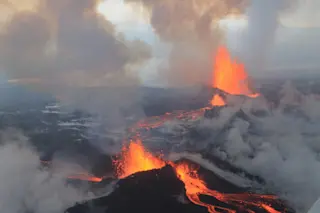Bárðarbunga Volcano in Iceland erupting on September 4, 2014. Credit: Peter Hartree via Flickr
This article was originally published on The Conversation.
The Earth seems to have been smoking a lot recently. Volcanoes are currently erupting in Iceland, Hawaii, Indonesia and Mexico. Others, in the Philippines and Papua New Guinea, erupted recently but seem to have calmed down. Many of these have threatened homes and forced evacuations. But among their less-endangered spectators, these eruptions may have raised a question: Is there such a thing as a season for volcanic eruptions? Surprisingly, this may be a possibility. While volcanoes may not have “seasons” as we know them, scientists have started to discern intriguing patterns in their activity.
The four seasons are caused by the Earth’s axis of rotation tilting towards and away from the sun. But our planet undergoes another, less well-known change, which affects it in a more subtle way. ...














